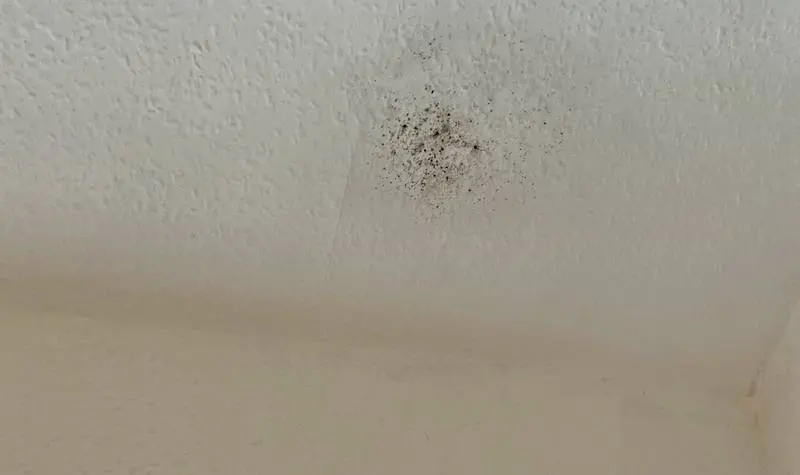The ambiance of a room can quickly turn from inviting to concerning when an unexpected black spot appears on the ceiling. Homeowners and tenants alike may find themselves puzzled by this unwelcome addition to their living space. In this comprehensive guide, we will explore the phenomenon of the “Black Spot on Ceiling,” unraveling its potential causes, implications, and the steps to address and prevent it.

Black Spot On Ceiling: Decoding the Enigma
The Appearance of the Intruder: What Causes a Black Spot on Ceiling?
The sudden emergence of a black spot on the ceiling can be disconcerting, prompting a series of questions about its origin. Understanding the various causes is crucial for effective identification and resolution.
- Water Damage: The Silent CulpritOne of the primary culprits behind black spots on the ceiling is water damage. Leaky roofs, burst pipes, or condensation issues can lead to the growth of mold and mildew. These fungi manifest as dark spots on the ceiling and often accompany a musty odor. It’s essential to address the water source promptly to prevent further damage.
- Smoke Stains: Lingering RemnantsIn homes with a history of smoking or insufficient ventilation, smoke stains can accumulate on the ceiling. Over time, these stains may darken, resulting in noticeable black spots. Proper ventilation and cleaning are essential to prevent the recurrence of these spots.
- Mold and Mildew: The Menace WithinMoisture-rich environments, such as bathrooms and kitchens, are breeding grounds for mold and mildew. These fungi thrive in damp conditions and can lead to the development of black spots on the ceiling. Regular cleaning and adequate ventilation can help keep these unwelcome guests at bay.
- Soot Accumulation: Fireplace FalloutHomes with fireplaces may experience black spots on the ceiling due to soot accumulation. While the aesthetic impact is immediate, prolonged exposure can pose respiratory risks. Regular chimney maintenance and cleaning are vital to preventing soot-related issues.
Identifying Water Damage
Understanding the specific cause of the black spot is crucial for effective remediation. In this section, we will delve deeper into the identification and resolution of black spots resulting from water damage.
Recognizing Water Damage: Signs and Symptoms
- Discoloration and Staining:Water-damaged areas often exhibit discoloration and staining. The black spot on the ceiling may be accompanied by water rings or streaks, indicating a persistent leak.
- Peeling Paint or Wallpaper:Moisture intrusion can compromise the integrity of paint or wallpaper. If the black spot is surrounded by peeling paint or wallpaper, it is likely a result of water damage.
- Musty Odor:A distinctive musty odor accompanies mold growth. If the black spot emits a musty smell, it’s a clear indicator of fungal presence, necessitating prompt attention.
Addressing Water Damage: Steps to Remediation
- Locate and Fix the Source:Identifying and repairing the source of water intrusion is paramount. Whether it’s a leaky roof, malfunctioning plumbing, or poor ventilation, addressing the root cause is crucial for preventing recurrence.
- Mold Removal:If mold is present, professional remediation may be necessary. DIY efforts may exacerbate the issue, leading to spore dispersion. Consultation with a mold remediation specialist ensures thorough and safe removal.
- Ceiling Repair:Once the water source and mold issues are resolved, repairing the damaged ceiling becomes the final step. This may involve patching, repainting, or, in severe cases, replacing portions of the ceiling.
Preventing the Return of the Black Spot: Maintenance Tips
Prevention is key when it comes to avoiding the reappearance of the black spot on the ceiling. Implementing proactive measures can safeguard your home from potential water damage and associated issues.
- Regular Roof Inspections:Schedule periodic roof inspections to identify and address potential vulnerabilities. Damaged shingles, flashing, or seals can contribute to water infiltration.
- Prompt Plumbing Repairs:Attend to plumbing issues promptly, addressing leaks and ensuring proper drainage. Regular maintenance can prevent water-related damage to ceilings and walls.
- Proper Ventilation:Enhance ventilation in moisture-prone areas such as bathrooms and kitchens. Vent fans, dehumidifiers, and open windows contribute to a drier environment, inhibiting mold and mildew growth.
- Chimney Maintenance:If your home features a fireplace, adhere to a regular chimney maintenance schedule. This includes professional cleaning to prevent the accumulation of soot and potential black spot formation.
Read too: Understanding Asbestos in Ceiling Plaster and Ensuring a Safe Home: Unveiling the Dangers
Conclusion: Banishing the Black Spot and Embracing Home Wellness
The black spot on the ceiling may initially evoke concern, but armed with knowledge, homeowners can tackle the issue effectively. By identifying the root cause, implementing remediation measures, and adopting preventative strategies, the menace of the black spot can be banished, leaving behind a home environment that promotes health, safety, and aesthetic appeal.
In your journey to a spot-free ceiling, remember that early detection and proactive maintenance are your strongest allies. Stay vigilant, address issues promptly, and enjoy a home free from the unwelcome presence of black spots.